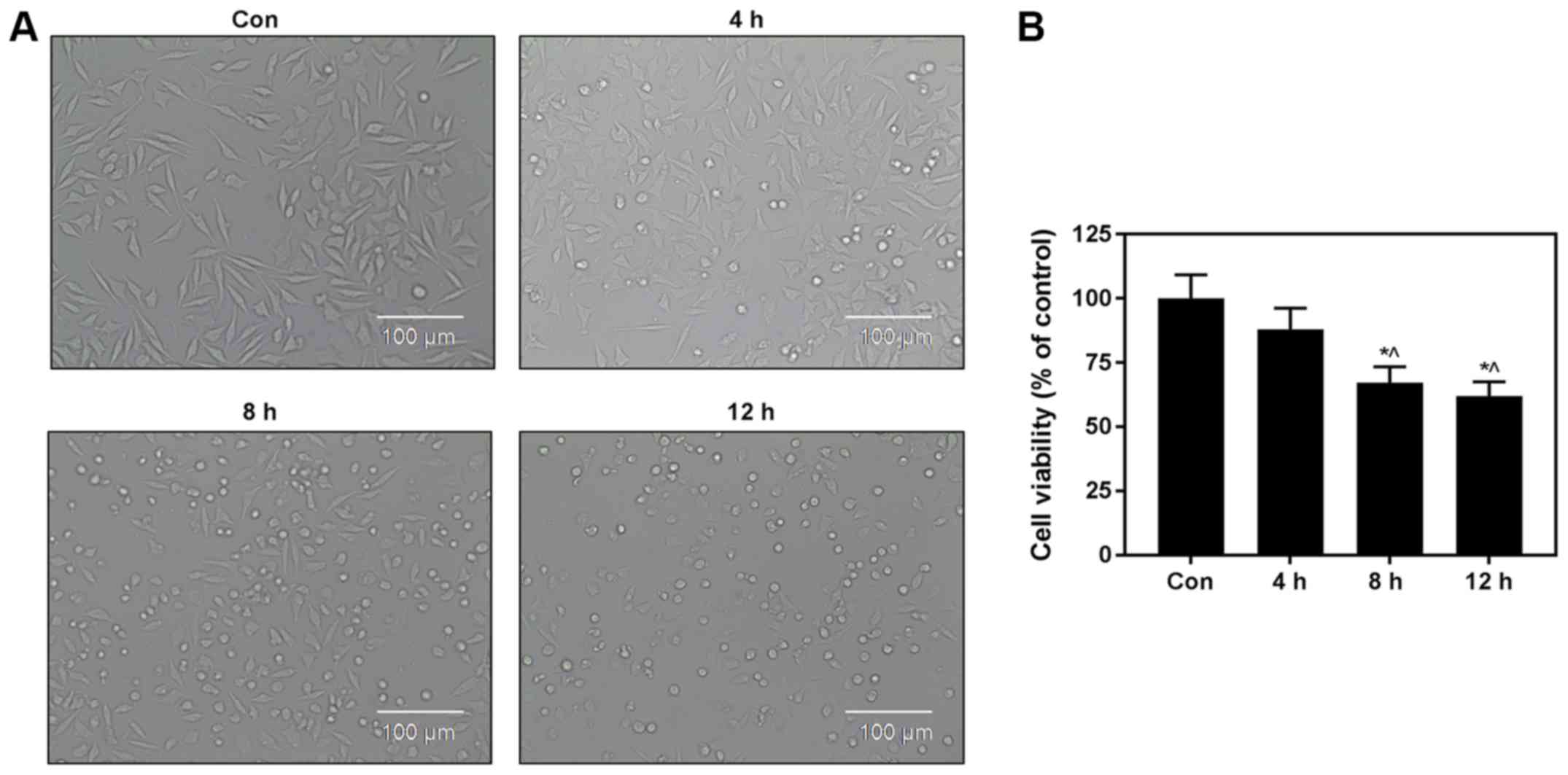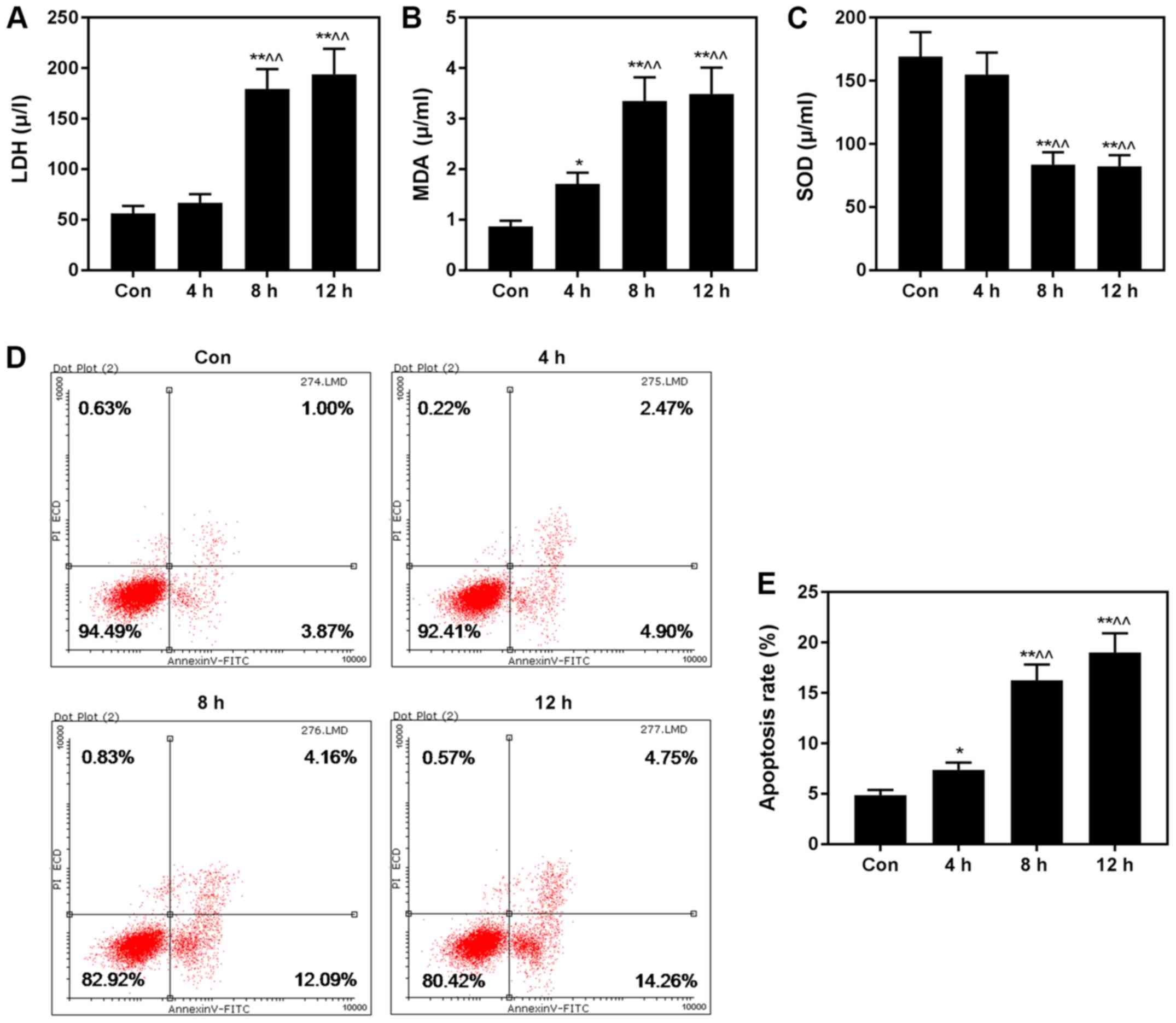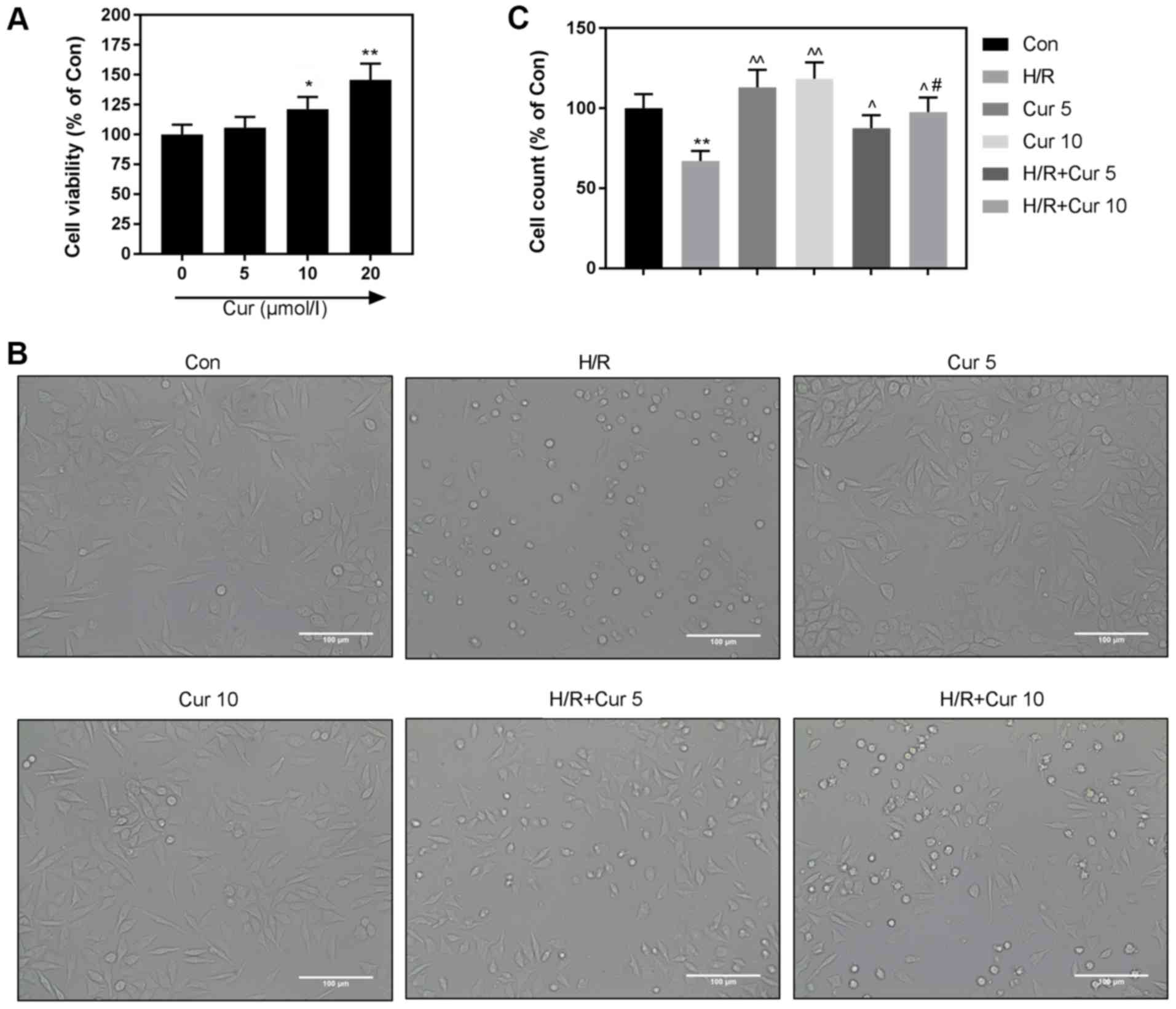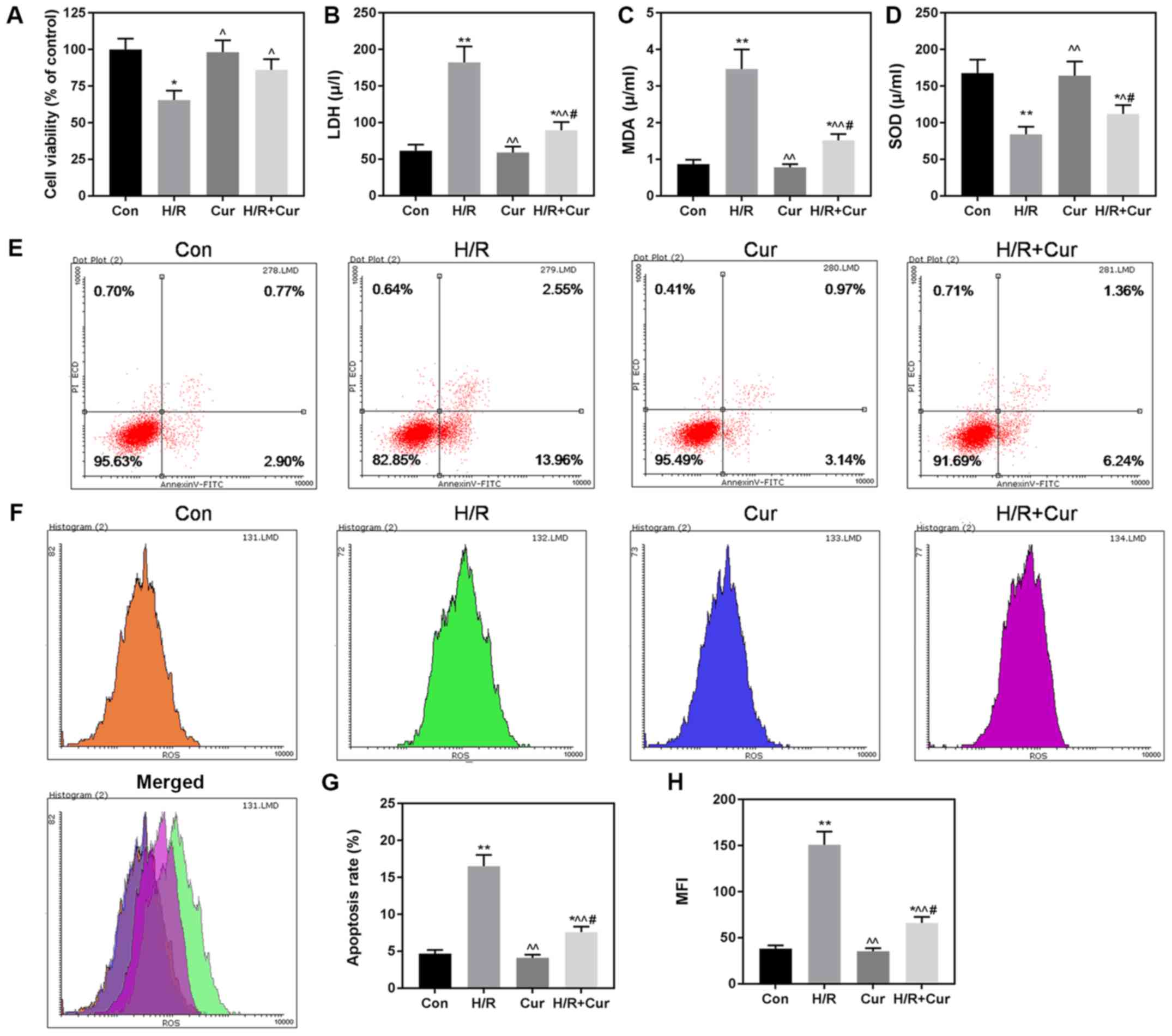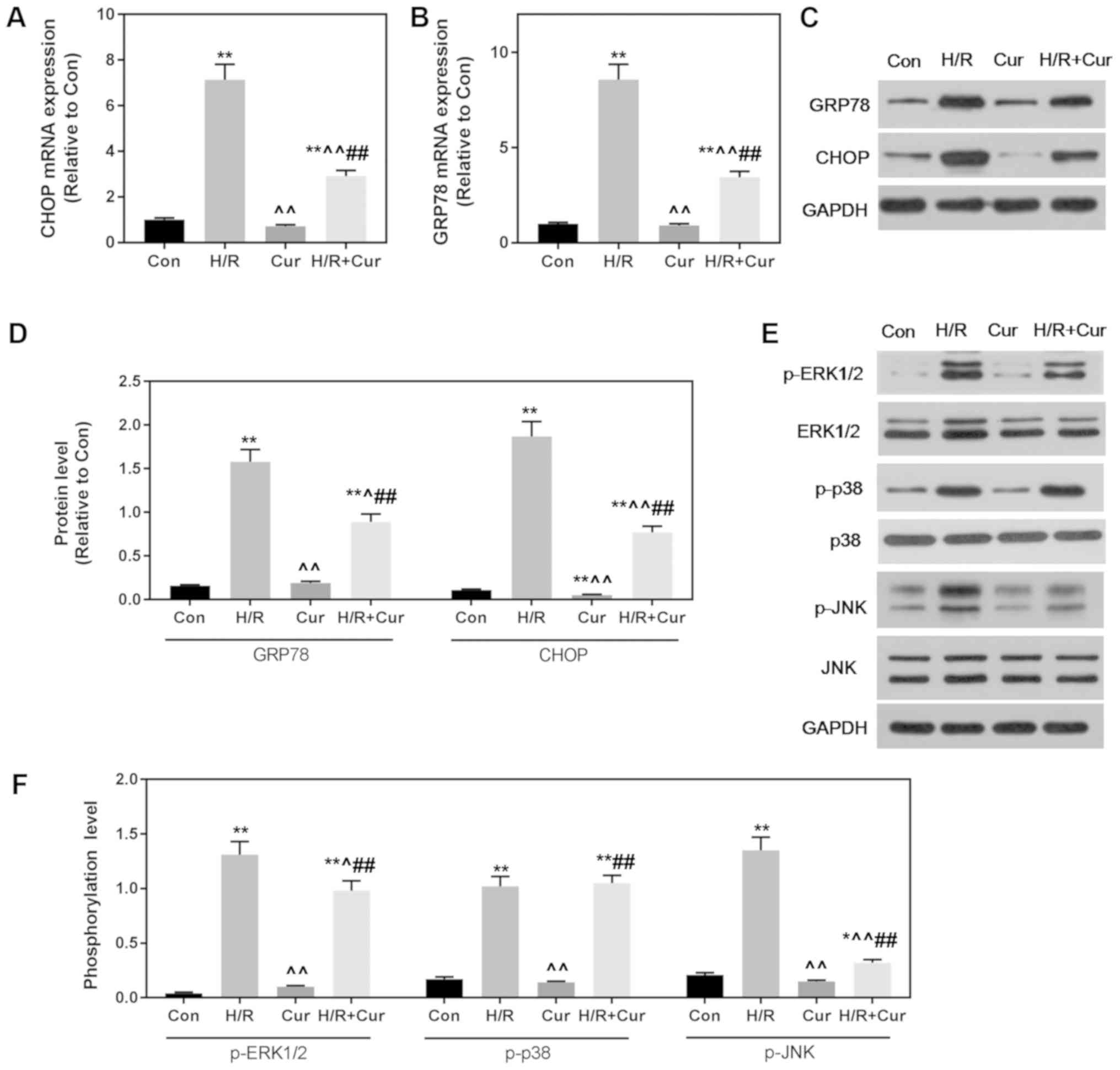|
1
|
Murphy E and Steenbergen C: Mechanisms
underlying acute protection from cardiac ischemia-reperfusion
injury. Physiol Rev. 88:581–609. 2008. View Article : Google Scholar : PubMed/NCBI
|
|
2
|
Frank A, Bonney M, Bonney S, Weitzel L,
Koeppen M and Eckle T: Myocardial ischemia reperfusion injury: From
basic science to clinical bedside. Semin Cardiothorac Vasc Anesth.
16:123–132. 2012. View Article : Google Scholar : PubMed/NCBI
|
|
3
|
Heusch G and Gersh BJ: The pathophysiology
of acute myocardial infarction and strategies of protection beyond
reperfusion: A continual challenge. Eur Heart J. 38:774–784.
2017.PubMed/NCBI
|
|
4
|
Hausenloy DJ and Yellon DM: Ischaemic
conditioning and reperfusion injury. Nat Rev Cardiol. 13:193–209.
2016. View Article : Google Scholar : PubMed/NCBI
|
|
5
|
Heusch G: Critical issues for the
translation of cardioprotection. Circ Res. 120:1477–1486. 2017.
View Article : Google Scholar : PubMed/NCBI
|
|
6
|
Zhuo XZ, Wu Y, Ni YJ, Liu JH, Gong M, Wang
XH, Wei F, Wang TZ, Yuan Z, Ma AQ and Song P: Isoproterenol
instigates cardiomyocyte apoptosis and heart failure via AMPK
inactivation-mediated endoplasmic reticulum stress. Apoptosis.
18:800–810. 2013. View Article : Google Scholar : PubMed/NCBI
|
|
7
|
Dalal S, Foster CR, Das BC, Singh M and
Singh K: Β-adrenergic receptor stimulation induces endoplasmic
reticulum stress in adult cardiac myocytes: Role in apoptosis. Mol
Cell Biochem. 364:59–70. 2012. View Article : Google Scholar : PubMed/NCBI
|
|
8
|
Wu T, Dong Z, Geng J, Sun Y, Liu G, Kang
W, Zhang Y and Ge Z: Valsartan protects against ER stress-induced
myocardial apoptosis via CHOP/Puma signaling pathway in
streptozotocin-induced diabetic rats. Eur J Pharm Sci. 42:496–502.
2011. View Article : Google Scholar : PubMed/NCBI
|
|
9
|
Fu HY, Okada K, Liao Y, Tsukamoto O,
Isomura T, Asai M, Sawada T, Okuda K, Asano Y, Sanada S, et al:
Ablation of C/EBP homologous protein attenuates endoplasmic
reticulum-mediated apoptosis and cardiac dysfunction induced by
pressure overload. Circulation. 122:361–369. 2010. View Article : Google Scholar : PubMed/NCBI
|
|
10
|
Wu XD, Zhang ZY, Sun S, Li YZ, Wang XR,
Zhu XQ, Li WH and Liu XH: Hypoxic preconditioning protects
microvascular endothelial cells against hypoxia/reoxygenation
injury by attenuating endoplasmic reticulum stress. Apoptosis.
18:85–98. 2013. View Article : Google Scholar : PubMed/NCBI
|
|
11
|
Sari FR, Widyantoro B, Thandavarayan RA,
Harima M, Lakshmanan AP, Zhang S, Muslin AJ, Suzuki K, Kodama M and
Watanabe K: Attenuation of CHOP-mediated myocardial apoptosis in
pressure-overloaded dominant negative p38α mitogen-activated
protein kinase mice. Cell Physiol Biochem. 27:487–496. 2011.
View Article : Google Scholar : PubMed/NCBI
|
|
12
|
Okada K, Minamino T, Tsukamoto Y, Liao Y,
Tsukamoto O, Takashima S, Hirata A, Fujita M, Nagamachi Y, Nakatani
T, et al: Prolonged endoplasmic reticulum stress in hypertrophic
and failing heart after aortic constriction: Possible contribution
of endoplasmic reticulum stress to cardiac myocyte apoptosis.
Circulation. 110:705–712. 2004. View Article : Google Scholar : PubMed/NCBI
|
|
13
|
Arumugam S, Thandavarayan RA, Arozal W,
Sari FR, Giridharan VV, Soetikno V, Palaniyandi SS, Harima M,
Suzuki K, Nagata M, et al: Quercetin offers cardioprotection
against progression of experimental autoimmune myocarditis by
suppression of oxidative and endoplasmic reticulum stress via
endothelin-1/MAPK signalling. Free Radic Res. 46:154–163. 2012.
View Article : Google Scholar : PubMed/NCBI
|
|
14
|
Muslin AJ: MAPK signalling in
cardiovascular health and disease: Molecular mechanisms and
therapeutic targets. Clin Sci (Lond). 115:203–218. 2008. View Article : Google Scholar : PubMed/NCBI
|
|
15
|
Chen S, Yang B, Xu Y, Rong Y and Qiu Y:
Protection of Luteolin-7-O-glucoside against apoptosis induced by
hypoxia/reoxygenation through the MAPK pathways in H9c2 cells. Mol
Med Rep. 17:7156–7162. 2018.PubMed/NCBI
|
|
16
|
Martin JL, Avkiran M, Quinlan RA, Cohen P
and Marber MS: Antiischemic effects of SB203580 are mediated
through the inhibition of p38alpha mitogen-activated protein
kinase: Evidence from ectopic expression of an inhibition-resistant
kinase. Circ Res. 89:750–752. 2001. View Article : Google Scholar : PubMed/NCBI
|
|
17
|
Nagarkatti DS and Sha'afi RI: Role of p38
MAP kinase in myocardial stress. J Mol Cell Cardiol. 30:1651–1664.
1998. View Article : Google Scholar : PubMed/NCBI
|
|
18
|
Maulik A, Davidson SM, Piotrowska I,
Walker M and Yellon DM: Ischaemic preconditioning protects
cardiomyocytes from anthracycline-induced toxicity via the PI3K
pathway. Cardiovasc Drugs Ther. 32:245–253. 2018. View Article : Google Scholar : PubMed/NCBI
|
|
19
|
Manolova Y, Deneva V, Antonov L, Drakalska
E, Momekova D and Lambov N: The effect of the water on the curcumin
tautomerism: A quantitative approach. Spectrochim Acta A Mol Biomol
Spectrosc. 132:815–820. 2014. View Article : Google Scholar : PubMed/NCBI
|
|
20
|
Sikora E, Scapagnini G and Barbagallo M:
Curcumin, inflammation, ageing and age-related diseases. Immun
Ageing. 7:12010. View Article : Google Scholar : PubMed/NCBI
|
|
21
|
Koeberle A and Werz O: Multi-target
approach for natural products in inflammation. Drug Discov Today.
19:1871–1882. 2014. View Article : Google Scholar : PubMed/NCBI
|
|
22
|
Nakmareong S, Kukongviriyapan U,
Pakdeechote P, Donpunha W, Kukongviriyapan V, Kongyingyoes B,
Sompamit K and Phisalaphong C: Antioxidant and vascular protective
effects of curcumin and tetrahydrocurcumin in rats with
L-NAME-induced hypertension. Naunyn Schmiedebergs Arch Pharmacol.
383:519–529. 2011. View Article : Google Scholar : PubMed/NCBI
|
|
23
|
Topcu-Tarladacalisir Y, Akpolat M, Uz YH,
Kizilay G, Sapmaz-Metin M, Cerkezkayabekir A and Omurlu IK: Effects
of curcumin on apoptosis and oxidoinflammatory regulation in a rat
model of acetic acid-induced colitis: The roles of c-Jun N-terminal
kinase and p38 mitogen-activated protein kinase. J Med Food.
16:296–305. 2013. View Article : Google Scholar : PubMed/NCBI
|
|
24
|
Anestopoulos I, Kavo A, Tentes I,
Kortsaris A, Panayiotidis M, Lazou A and Pappa A: Silibinin
protects H9c2 cardiac cells from oxidative stress and inhibits
phenylephrine-induced hypertrophy: Potential mechanisms. J Nutr
Biochem. 24:586–594. 2013. View Article : Google Scholar : PubMed/NCBI
|
|
25
|
Jia WQ, Wang ZT, Zou MM, Lin JH, Li YH,
Zhang L and Xu RX: Verbascoside inhibits glioblastoma cell
proliferation, migration and invasion while promoting apoptosis
through upregulation of protein tyrosine phosphatase SHP-1 and
inhibition of STAT3 phosphorylation. Cell Physiol Biochem.
47:1871–1882. 2018. View Article : Google Scholar : PubMed/NCBI
|
|
26
|
Al-Obeed O, Vaali-Mohammed MA, Eldehna WM,
Al-Khayal K, Mahmood A, Abdel-Aziz HA, Zubaidi A, Alafeefy A,
Abdulla M and Ahmad R: Novel quinazoline-based sulfonamide
derivative (3D) induces apoptosis in colorectal cancer by
inhibiting JAK2-STAT3 pathway. OncoTargets Ther. 11:3313–3322.
2018. View Article : Google Scholar
|
|
27
|
Livak KJ and Schmittgen TD: Analysis of
relative gene expression data using real-time quantitative PCR and
the 2(-Delta Delta C(T)) method. Methods. 25:402–408. 2001.
View Article : Google Scholar : PubMed/NCBI
|
|
28
|
Naserzadeh P, Mehr SN, Sadabadi Z, Seydi
E, Salimi A and Pourahmad J: Curcumin protects mitochondria and
cardiomyocytes from oxidative damage and apoptosis induced by
Hemiscorpius lepturus venom. Drug Res (Stuttg). 68:113–120.
2018. View Article : Google Scholar : PubMed/NCBI
|
|
29
|
Lv FH, Yin HL, He YQ, Wu HM, Kong J, Chai
XY and Zhang SR: Effects of curcumin on the apoptosis of
cardiomyocytes and the expression of NF-κB, PPAR-γ and Bcl-2 in
rats with myocardial infarction injury. Exp Ther Med. 12:3877–3884.
2016. View Article : Google Scholar : PubMed/NCBI
|
|
30
|
Hescheler J, Meyer R, Plant S, Krautwurst
D, Rosenthal W and Schultz G: Morphological, biochemical, and
electrophysiological characterization of a clonal cell (H9c2) line
from rat heart. Circ Res. 69:1476–1486. 1991. View Article : Google Scholar : PubMed/NCBI
|
|
31
|
Dai D, Yang J, Zhao C, Wu H, Ding J, Sun X
and Hu S: Effect of geranylgeranyl pyrophosphate synthase on
hypoxia/reoxygenation-induced injury in heart-derived H9c2 cells.
Int Heart J. 59:821–828. 2018. View Article : Google Scholar : PubMed/NCBI
|
|
32
|
Cheng J, Wu Q, Lv R, Huang L, Xu B, Wang
X, Chen A and He F: MicroRNA-449a inhibition protects H9C2 cells
against hypoxia/reoxygenation-induced injury by targeting the
Notch-1 signaling pathway. Cell Physiol Biochem. 46:2587–2600.
2018. View Article : Google Scholar : PubMed/NCBI
|
|
33
|
Yang HH, Chen Y, Gao CY, Cui ZT and Yao
JM: Protective effects of microRNA-126 on human cardiac
microvascular endothelial cells against
hypoxia/reoxygenation-induced injury and inflammatory response by
activating PI3K/Akt/eNOS signaling pathway. Cell Physiol Biochem.
42:506–518. 2017. View Article : Google Scholar : PubMed/NCBI
|
|
34
|
Cai Y, Hu X, Yi B, Zhang T and Wen Z:
Glucagon-like peptide-1 receptor agonist protects against
hyperglycemia-induced cardiocytes injury by inhibiting high
mobility group box 1 expression. Mol Biol Rep. 39:10705–10711.
2012. View Article : Google Scholar : PubMed/NCBI
|
|
35
|
Bartz RR, Suliman HB and Piantadosi CA:
Redox mechanisms of cardiomyocyte mitochondrial protection. Front
Physiol. 6:2912015. View Article : Google Scholar : PubMed/NCBI
|
|
36
|
Granger DN and Kvietys PR: Reperfusion
injury and reactive oxygen species: The evolution of a concept.
Redox Biol. 6:524–551. 2015. View Article : Google Scholar : PubMed/NCBI
|
|
37
|
Fan Q, Chen M, Fang X, Lau WB, Xue L, Zhao
L, Zhang H, Liang YH, Bai X, Niu HY, et al: Aging might augment
reactive oxygen species (ROS) formation and affect reactive
nitrogen species (RNS) level after myocardial ischemia/reperfusion
in both humans and rats. Age (Dordr). 35:1017–1026. 2013.
View Article : Google Scholar : PubMed/NCBI
|
|
38
|
Rachmat FD, Rachmat J, Sastroasmoro S and
Wanandi SI: Effect of allopurinol on oxidative stress and hypoxic
adaptation response during surgical correction of tetralogy of
fallot. Acta Med Indones. 45:94–100. 2013.PubMed/NCBI
|
|
39
|
Liu M, Zhang P, Chen M, Zhang W, Yu L,
Yang XC and Fan Q: Aging might increase myocardial
ischemia/reperfusion-induced apoptosis in humans and rats. Age
(Dordr). 34:621–632. 2012. View Article : Google Scholar : PubMed/NCBI
|
|
40
|
Hu Q, Luo W, Huang L, Huang R and Chen R:
Apoptosis-related microRNA changes in the right atrium induced by
remote ischemic perconditioning during valve replacement surgery.
Sci Rep. 6:189592016. View Article : Google Scholar : PubMed/NCBI
|
|
41
|
Li Q, Xiang Y, Chen Y, Tang Y and Zhang Y:
Ginsenoside Rg1 protects cardiomyocytes against
hypoxia/reoxygenation injury via activation of Nrf2/HO-1 signaling
and inhibition of JNK. Cell Physiol Biochem. 44:21–37. 2017.
View Article : Google Scholar : PubMed/NCBI
|
|
42
|
Molavi B and Mehta JL: Oxidative stress in
cardiovascular disease: Molecular basis of its deleterious effects,
its detection, and therapeutic considerations. Curr Opin Cardiol.
19:488–493. 2004. View Article : Google Scholar : PubMed/NCBI
|
|
43
|
Zhang C, Tang Y, Li Y, Xie L, Zhuang W,
Liu J and Gong J: Unfolded protein response plays a critical role
in heart damage after myocardial ischemia/reperfusion in rats. PLoS
One. 12:e01790422017. View Article : Google Scholar : PubMed/NCBI
|
|
44
|
Xu J, Hu H, Chen B, Yue R, Zhou Z, Liu Y,
Zhang S, Xu L, Wang H and Yu Z: Lycopene protects against
hypoxia/reoxygenation injury by alleviating ER stress induced
apoptosis in neonatal mouse cardiomyocytes. PLoS One.
10:e01364432015. View Article : Google Scholar : PubMed/NCBI
|
|
45
|
Zou XJ, Yang L and Yao SL: Endoplasmic
reticulum stress and C/EBP homologous protein-induced Bax
translocation are involved in angiotensin II-induced apoptosis in
cultured neonatal rat cardiomyocytes. Exp Biol Med (Maywood).
237:1341–1349. 2012. View Article : Google Scholar : PubMed/NCBI
|
|
46
|
Gupta MK, Tahrir FG, Knezevic T, White MK,
Gordon J, Cheung JY, Khalili K and Feldman AM: GRP78 interacting
partner Bag5 responds to ER stress and protects cardiomyocytes from
ER stress-induced apoptosis. J Cell Biochem. 117:1813–1821. 2016.
View Article : Google Scholar : PubMed/NCBI
|
|
47
|
Long M, Chen X, Wang N, Wang M, Pan J,
Tong J, Li P, Yang S and He J: Proanthocyanidins protect epithelial
cells from zearalenone-induced apoptosis via inhibition of
endoplasmic reticulum stress-induced apoptosis pathways in mouse
small intestines. Molecules. 23:E15082018. View Article : Google Scholar : PubMed/NCBI
|
|
48
|
Gorman AM, Healy SJ, Jäger R and Samali A:
Stress management at the ER: Regulators of ER stress-induced
apoptosis. Pharmacol Ther. 134:306–316. 2012. View Article : Google Scholar : PubMed/NCBI
|
|
49
|
Xia Z, Dickens M, Raingeaud J, Davis RJ
and Greenberg ME: Opposing effects of ERK and JNK-p38 MAP kinases
on apoptosis. Science. 270:1326–1331. 1995. View Article : Google Scholar : PubMed/NCBI
|
|
50
|
Yue TL, Wang C, Gu JL, Ma XL, Kumar S, Lee
JC, Feuerstein GZ, Thomas H, Maleeff B and Ohlstein EH: Inhibition
of extracellular signal-regulated kinase enhances
Ischemia/Reoxygenation-induced apoptosis in cultured cardiac
myocytes and exaggerates reperfusion injury in isolated perfused
heart. Circ Res. 86:692–699. 2000. View Article : Google Scholar : PubMed/NCBI
|
|
51
|
See F, Thomas W, Way K, Tzanidis A, Kompa
A, Lewis D, Itescu S and Krum H: p38 mitogen-activated protein
kinase inhibition improves cardiac function and attenuates left
ventricular remodeling following myocardial infarction in the rat.
J Am Coll Cardiol. 44:1679–1689. 2004. View Article : Google Scholar : PubMed/NCBI
|
|
52
|
Hassanzade A, Mandegary A, Sharif E,
Rasooli R, Mohammadnejad R and Masoumi-Ardekani Y: Cyclooxygenase
inhibitors combined with deuterium-enriched water augment
cytotoxicity in A549 lung cancer cell line via activation of
apoptosis and MAPK pathways. Iran J Basic Med Sci. 21:508–516.
2018.PubMed/NCBI
|















